Smart Trash Bin Model Design and Future for Smart City
Abstract
:1. Introduction
2. Related Research
2.1. Smart Trash Bin Model Design
2.2. Trash Image Classification
2.3. Trash Classification Using Spectroscopy
3. Model Design
3.1. A Design of the IoT-Based Smart Trash Bin
3.2. Expectation Effectiveness
4. Comparison with Other Cases and Performance Evaluation
5. Conclusions and Future Work
Author Contributions
Funding
Institutional Review Board Statement
Informed Consent Statement
Data Availability Statement
Acknowledgments
Conflicts of Interest
Abbreviations
| ROK | Republic of Korea |
| IoT | Internet of Things |
| U.S. | United States |
| EPA | Environmental Protection Agency |
| NYC | New York City |
| EU | European Union |
| ITB | Intelligent Trash Bin |
| RFID | Radio-Frequency Identification |
| GPS | Global Positioning System |
| LED | Light-Emitting Diode |
| DC | Direct Current |
| LCD | Liquid Crystal Display |
| GSM | Global System for Mobile Communication |
| RIP | Passive Infrared |
| CNN | Convolutional Neural Network |
| SVM | Support Vector Machine |
| RF | Random Forest |
| XGBoost | eXtreme Gradient Boosting |
| kNN | k Nearest Neighbor |
| ResNet50 | Residual Neural Network 50-layer |
| ILSVRE | ImageNet Large-Scale Visual Recognition Challenge |
| DenseNets | Densely Connected Convolutional Networks |
| DNN-TC | Deep Neural Networks for Trash Classification |
| Res-NeXt | Aggregated Residual Transformations for Deep Neural |
| CVPR | Computer Vision and Pattern Recognition |
| DB | Database |
| FT-IR | Fourier-Transform Infrared |
Appendix A
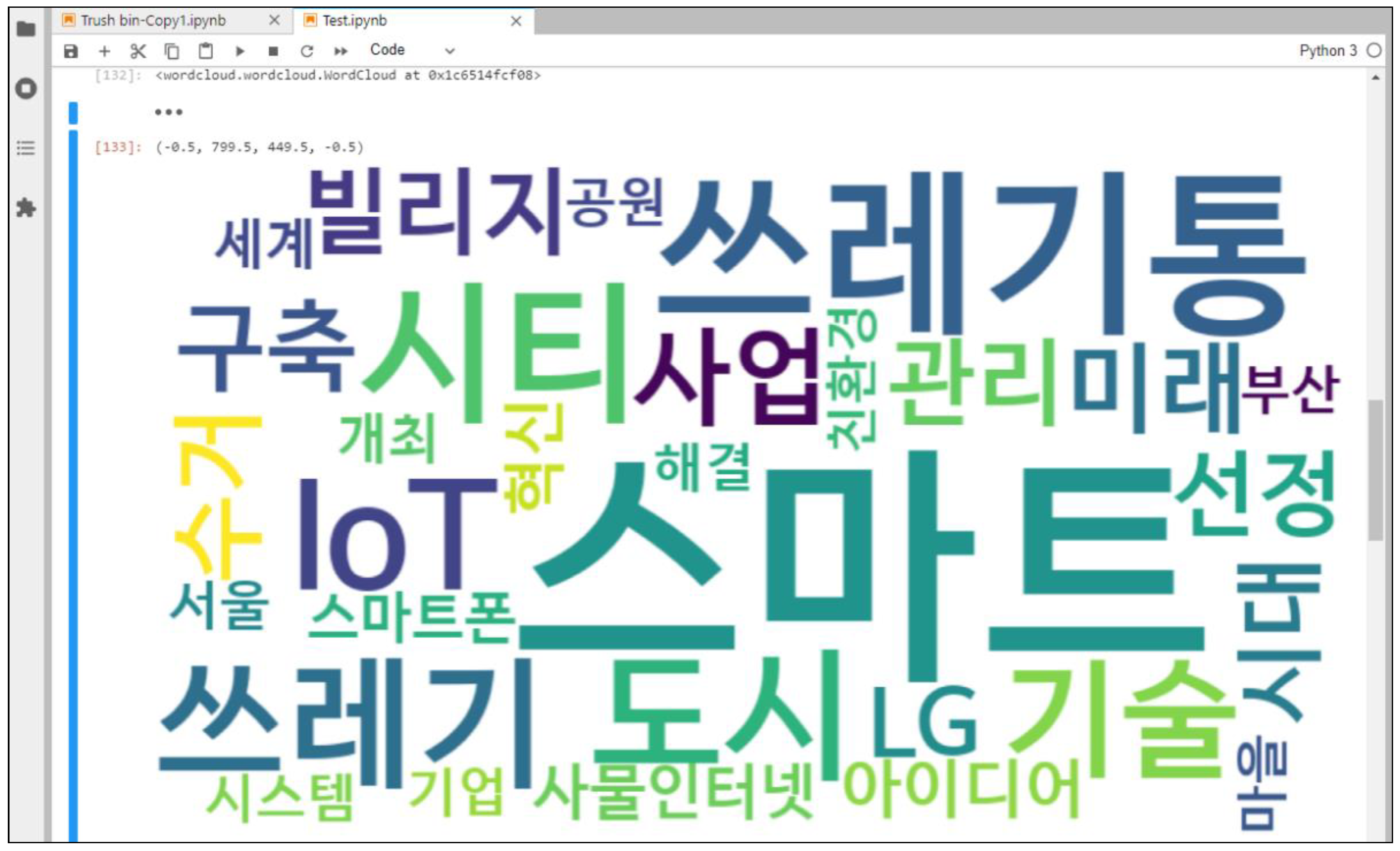
| Rank | Korean | English | Rank | Korean | English |
|---|---|---|---|---|---|
| 1 | 스마트 | Smart | 16 | 시대 | Era |
| 2 | 쓰레기통 | Trash Bin | 17 | 아이디어 | Idea |
| 3 | 시티 | City | 18 | 혁신 | Innovation |
| 4 | 도시 | City | 19 | 사물인터넷 | IoT |
| 5 | IoT | Internet of Things | 20 | 스마트폰 | Smartphone |
| 6 | 쓰레기 | Trash | 21 | 세계 | Wolrd |
| 7 | 기술 | Technology | 22 | 개최 | Open |
| 8 | 사업 | Business | 23 | 친환경 | Eco-friendly |
| 9 | 미래 | Future | 24 | 기업 | Corporation |
| 10 | 구축 | Build/Construct | 25 | 시스템 | System |
| 11 | 빌리지 | Village | 26 | 마을 | Village |
| 12 | 관리 | Management | 27 | 서울 | Seoul |
| 13 | 수거 | Collection | 28 | 공원 | Park |
| 14 | 선정 | Selection | 29 | 해결 | Solution |
| 15 | LG | LG (ROK company) | 30 | 부산 | Busan |



References
- Seoul Metropolitan Govermment. Available online: https://www.seoul.go.kr/news/news_report.do#view/318053?tr_code=snews (accessed on 28 April 2021).
- Seoul Open Data Plaza. Available online: https://data.seoul.go.kr/dataList/OA-15068/S/1/datasetView.do (accessed on 28 April 2021).
- Seoul Open Data Plaza. Available online: https://data.seoul.go.kr/dataList/375/S/2/datasetView.do (accessed on 28 April 2021).
- National Framework for Advancing the U.S. Recycling System; U.S. EPA: Washington, DC, USA, 2019.
- STREETSBLOG NYC. Will NYC Finally Get Garbage Out of Pedestrians’ Way? Available online: https://nyc.streetsblog.org/2019/06/04/will-nyc-finally-get-garbage-out-of-pedestrians-way/ (accessed on 12 May 2021).
- WTTW. Ask Geoffrey: A Brief History of Chicago’s Trash. Available online: https://news.wttw.com/2020/05/28/ask-geoffrey-brief-history-chicago-trash (accessed on 12 May 2021).
- Climate Policy Watcher. Waste Management in Europe. Available online: https://www.climate-policy-watcher.org/waste-management/waste-management-in-europe.html (accessed on 12 May 2021).
- European Enviroment Agency. Waste Recycling. Available online: https://www.eea.europa.eu/data-and-maps/indicators/waste-recycling-1/assessment-1 (accessed on 12 May 2021).
- Fauziah, I.B. Esthetic, integrated, smart and green trash bin for public space: A review. IOP Conf. Ser. Earth Environ. Sci. 2020, 575, 1–6. [Google Scholar] [CrossRef]
- Chandra, R.P.; Tawami, T. Design of Smart Trash Bin. IOP Conf. Ser. Mater. Sci. Eng. 2020, 879, 1–6. [Google Scholar] [CrossRef]
- Rahmayanti, H.; Oktaviani, V.; Syani, Y. The implementation of smart trash as smart environment concept. E3S Web Conf. 2018, 74, 1–5. [Google Scholar] [CrossRef]
- Haribabu, P.; Kassa, S.R.; Nagaraju, J.; Karthik, R.; Shirisha, N.; Anila, M. Implementation of a Smart Waste Management system using IoT. In Proceedings of the International Conference on Intelligent Sustainable Systems (ICISS), Palladam, India, 7–8 December 2017; pp. 1155–1156. [Google Scholar]
- Ravale, U.; Khade, A.; Patel, N.; Chaure, S. Smart Trash: An Efficient Way for Monitoring Solid Waste Management. In Proceedings of the International Conference on Current Trends in Computer, Electrical, Electronics and Communication (CTCEEC), Mysore, India, 8–9 September 2017; pp. 1135–1137. [Google Scholar]
- Karnalim, O.; Wongso, O.; Budiman, V.E.; Jonathan, F.C.; Manuel, B.A.; Marlina, M. A Persuasive Technology for Managing Waste Disposal through Smart Trash Bin and Waste Disposal Tracker. Int. J. Inf. Commun. Technol. (IJOICT) 2020, 6, 41–51. [Google Scholar] [CrossRef]
- Utomo, S.K.T.; Koshizuka, T.H.; Koshizuka, N. Blockchain-based Incentive System for Public Trash Bin. In Proceedings of the IEEE 9th Global Conference on Consumer Electronics (GCCE), Kobe, Japan, 13–16 October 2020; pp. 168–172. [Google Scholar]
- Maulana, F.R.; Widyanto, T.A.S.; Pratama, Y.; Mutijarsa, K. Design and Development of Smart Trash Bin Prototype for Municipal Solid Waste Management. In Proceedings of the International Conference on ICT for Smart Society (ICISS), Semarang, Indonesia, 10–11 October 2018. [Google Scholar]
- Sohail, H.; Ullah, S.; Khan, A.; Samin, O.B.; Omar, M. Intelligent Trash Bin (ITB) with Trash Collection Efficiency Optimization using IoT Sensing. In Proceedings of the 2019 8th International Conference on Information and Communication Technologies (ICICT), Karachi, Pakistan, 16–17 November 2019; pp. 48–53. [Google Scholar]
- Kim, T.-K. IoT (Internet of Things)-based Smart Trash Can. J. Korea Internet Things Soc. 2020, 6, 17–22. [Google Scholar]
- Wahab, M.H.A.; Kadir, A.A.; Tomari, M.R.; Jabbar, M.H. Smart Recycle Bin: A Conceptual Approach of Smart Waste Management with Integrated Web Based System. In Proceedings of the 2014 International Conference on IT Convergence and Security (ICITCS), Beijing, China, 28–30 October 2014; pp. 1–4. [Google Scholar]
- Balamurugan, S.; Ajithx, A.; Ratnakaran, S.; Balaji, S.; Marimuthu, R. Design of smart waste management system. In Proceedings of the 2017 International conference on Microelectronic Devices, Circuits and Systems (ICMDCS), Vellore, India, 10–12 August 2017; pp. 1–4. [Google Scholar]
- Kumar, S.V.; Kumaran, T.S.; Kumar, A.K.; Mathapati, M. Smart Garbage Monitoring and Clearance System using Internet of Things. In Proceedings of the 2017 IEEE International Conference on Smart Technologies and Management for Computing, Communication, Controls, Energy and Materials (ICSTM), Chennai, India, 2–4 August 2017. [Google Scholar]
- Fady, E.; Samann, F. The Design and Implementation of Samrt Trash Bin. Acad. J. Nawroz Univ. 2019, 6, 141–148. [Google Scholar]
- Wilson, S.T.; Sebastine, T.K.; Daniel, M.; Martin, V.; Neeum, R. Smart trash bin for waste management using odor sensor based on IoT technology. Int. J. Adv. Tesearch Ideas Innov. Technol. 2019, 5, 2048–2051. [Google Scholar]
- Salimi, I.; Dewantara, B.S.B.; Wibowo, I.K. Visual-based trash detection and classification system for smart trash bin robot. In Proceedings of the International Electronics Symposium on Knowledge Creation and Intelligent Compution, Bali, Indonesia, 29–30 January 2018; pp. 378–383. [Google Scholar]
- Satvilkar, M. Image Based Trash Classification using Machine Learning Algorithms for Recyclability Status; National College of Ireland: Dublin, Ireland, 2018; MSc Research Project. [Google Scholar]
- Bircanoğlu, C.; Atay, M.; Beşer, F.; Genç, Ö.; Kızrak, M.A. RecycleNet: Intelligent Waste Sorting Using Deep Neural Networks. In Proceedings of the 2018 Innovations in Intelligent Systems and Applications (INISTA), Teessaloniki, Greece, 3–5 July 2018; pp. 1–7. [Google Scholar]
- Yang, H.; Lu, T.; Guo, W.; Chang, S.; Song, J. RecycleTrashNet: Strengthening Training Efficiency for Trash Classification Via Composite Pooling. In Proceedings of the 2020 2nd International Conference on Advanced Control, Automation and Artificial Intelligence (ACAAI 2020), Wuhan, China, 11–13 January 2020; pp. 77–82. [Google Scholar]
- Anh, H.V.; Son, L.H.; Vo, M.T.; Le, T. A Novel Framework for Trash Classification Using Deep Transfer Learning. IEEE Access 2019, 7, 178631–178639. [Google Scholar]
- Xie, S.; Girshick, R.; Dollar, P.; Tu, Z.; He, K. Aggregated Residual Transformations for Deep Neural Networks. In Proceedings of the IEEE Conference on Computer Vision and Pattern Recognition (CVPR), Honolulu, HI, USA, 21–26 July 2017; pp. 1492–1500. [Google Scholar]
- Bernardo, S.C.; Bernardes, A.C.S.; Pereira, J.V.A.; Zampa, V.H.; Pereira, V.A.; Matos, G.F.; Soares, E.A.; Soares, C.L.; Silva, A.F. Artificial Intelligence in Automated Sorting in Trash Recycling. In Proceedings of the Anais do XV Encontro Nacional de Inteligência Artificial e Computacional (ENIAC), Sao Paulo, Brazil, 22–25 October 2018; pp. 198–205. [Google Scholar]
- Bauer, R.; Nieuwoudt, H.; Bauer, F.F.; Kossmann, J.; Koch, K.R.; Esbensen, K.H. FTIR SPECTROSCOP for Grape and Wine Analysis. Anal. Chem. 2008, 80, 1371–1379. [Google Scholar] [CrossRef] [PubMed] [Green Version]
- Rohman, A.; CheMan, Y.B. Fourier transform infrared (FTIR) spectroscopy for analysis of extra virgin olive oil adulterated with palm oil. Food Res. Int. 2010, 43, 886–892. [Google Scholar] [CrossRef]
- Smidt, E.; Meissl, K. The applicability of Fourier transform infrared (FT-IR) spectroscopy in waste management. Waste Manag. 2007, 27, 268–276. [Google Scholar] [CrossRef] [PubMed]
- Smidt, E.; Schwanninger, M. Characterization of Waste Materials Using FTIR Spectroscopy: Process Monitoring and Quality Assessment. Spectrosc. Lett. Spectrosc. Lett. 2005, 38, 237–270. [Google Scholar] [CrossRef]
- ECOTRADE. Available online: http://www.ecotrade.org/homepage/ecosave/catalog.asp?DirectoryID=660&CatalogID=586 (accessed on 28 April 2021).
- ECUBE LABS. Available online: http://ecubelabs.com/ (accessed on 28 April 2021).
- PUGEDON. Available online: https://www.pugedon.com/ (accessed on 28 April 2021).
- INCOM RECYCLE. Available online: http://en.incomrecycle.com/column/97/ (accessed on 14 May 2021).
- Han, S.C.; Liang, Y.; Chung, H.; Kim, H.; Kang, B.H. Information Technology and Management; Springer: Berlin/Heidelberg, Germany, 2016; Volume 17, pp. 133–139. [Google Scholar]
- Garnaev, A.; Hayel, Y.; Altman, E. A Bayesian Jamming Game in an OFDM Wireless Network. In Proceedings of the 10th International Symposium on Modeling and Optimization in Mobile, Paderborn, Germany, 14–18 May 2012; pp. 44–48. [Google Scholar]
- Maillé, P.; Tuffin, B.; Vigne, J.M. Competition between Wireless Service Providers Sharing a Radio Resource, Networking 2012; Lecture Notes in Computer Science; Springer: Berlin/Heidelberg, Germany, 2012; Volume 7290, pp. 355–365. [Google Scholar]
- Kesidis, G.; Hamadeh, I.; Jin, Y.; Jiwasurat, S.; Vojnović, M. A model of the spread of randomly scanning Internet worms that saturate access links. ACM Trans. Modeling Comput. Simul. 2008, 18, 6. [Google Scholar] [CrossRef]
- Huh, J.-H.; Kwak, S.-Y.; Lee, S.-Y.; Seo, K. A Design of Small-Size Smart Trash Separation Box Using ICT Technology. Asia-pacific Proceedings of Applied Science and Engineering for Better Human Life. In Proceedings of the 10th 2016 International Interdisciplinary Workshop Series at Jeju National University, Jeju, Korea, 16–19 August 2016; Volume 4, pp. 141–144. [Google Scholar]
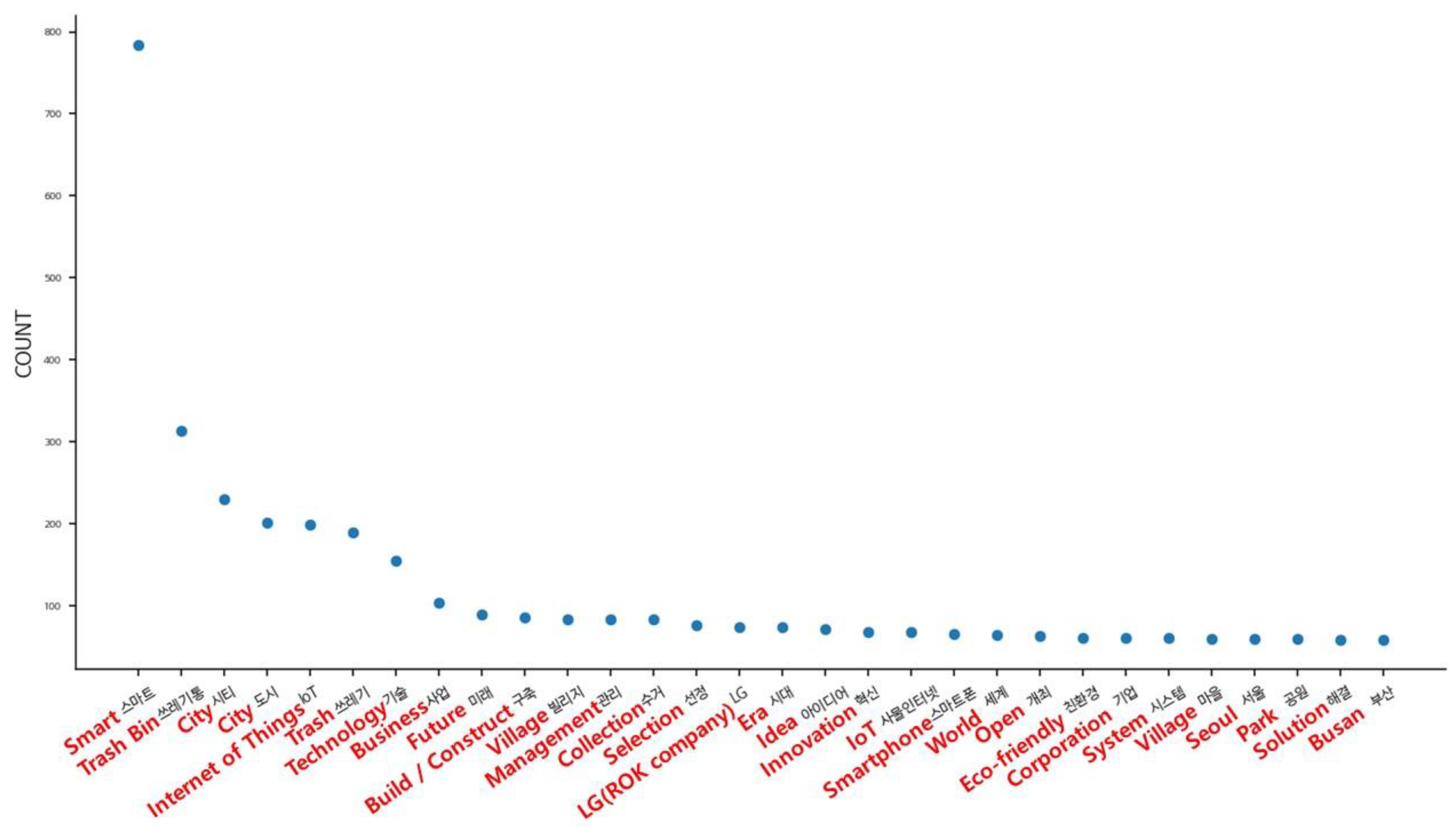
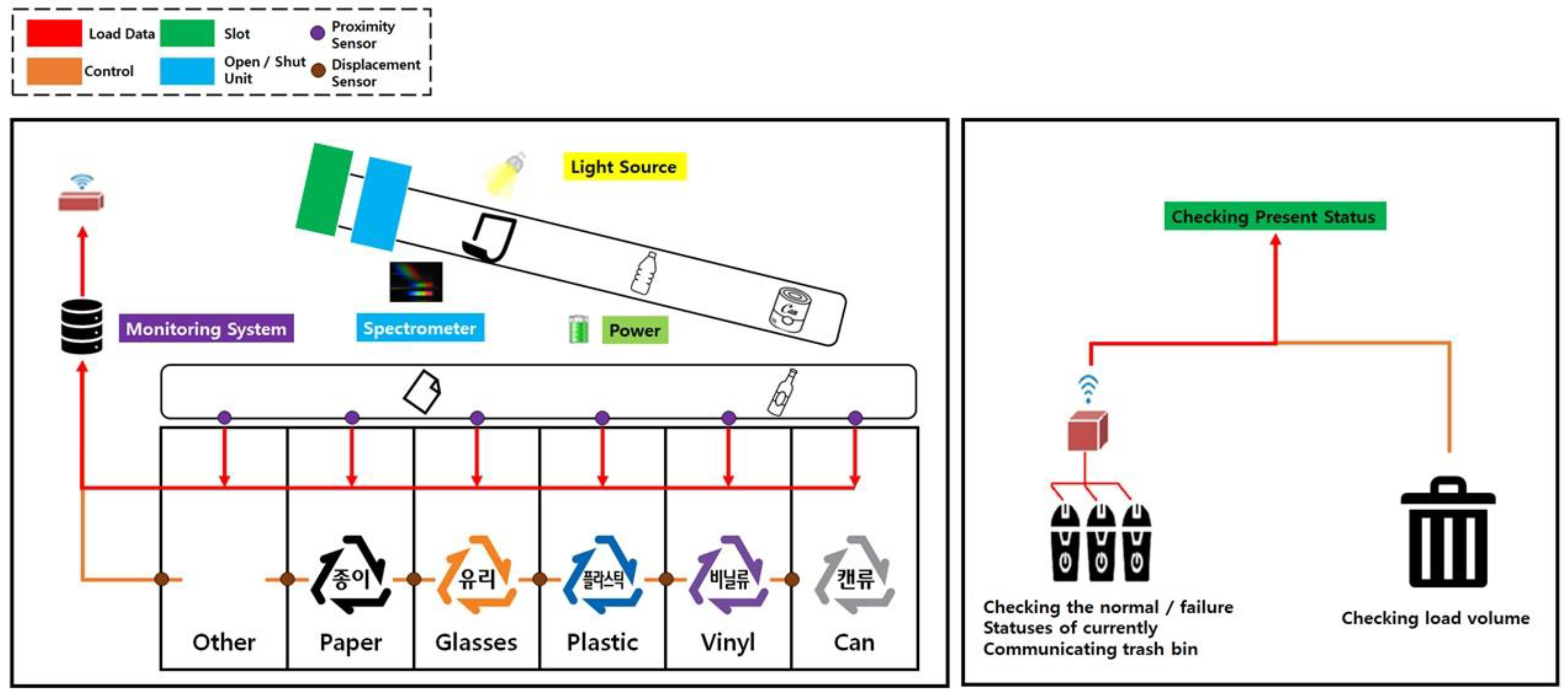
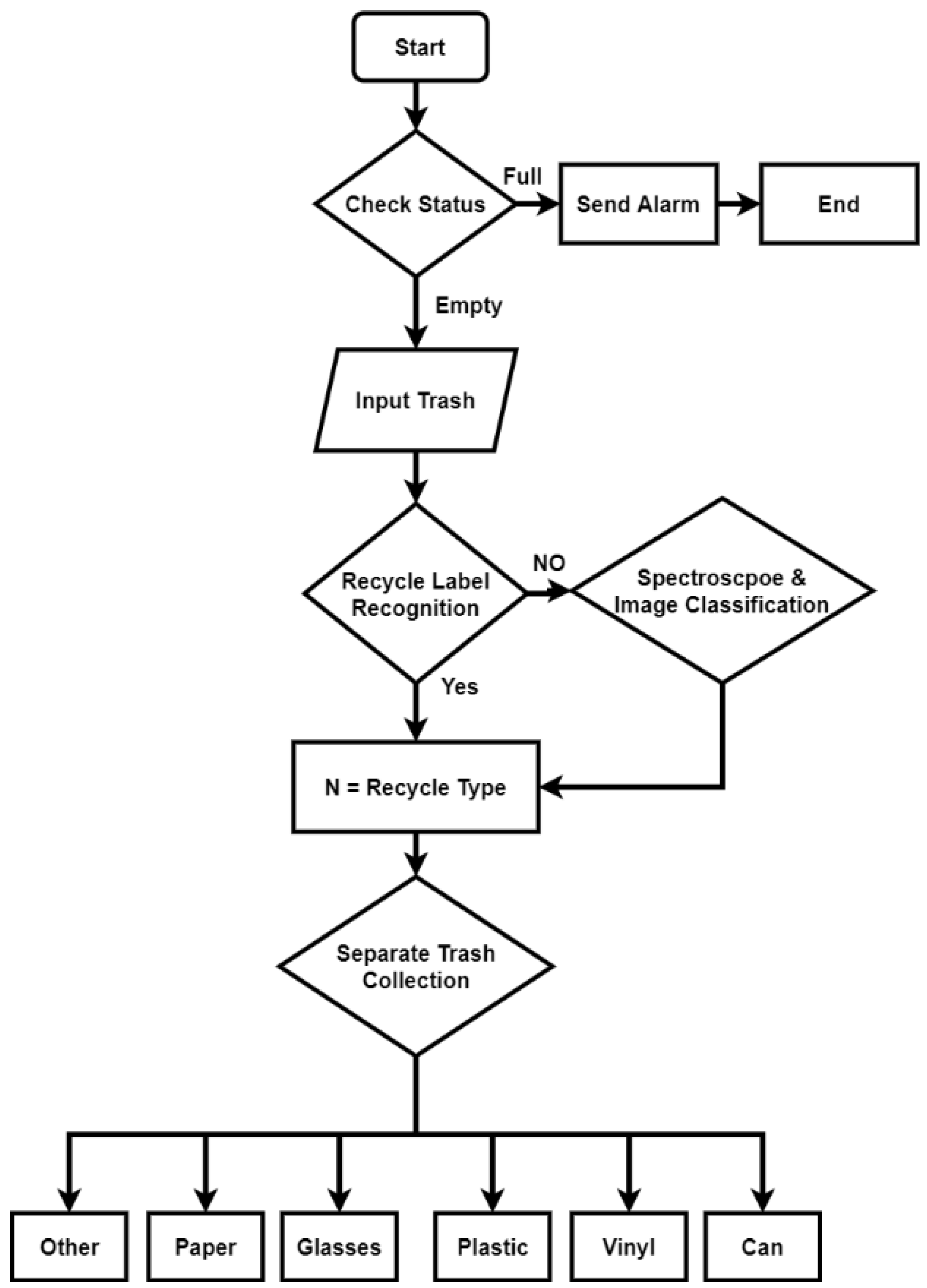
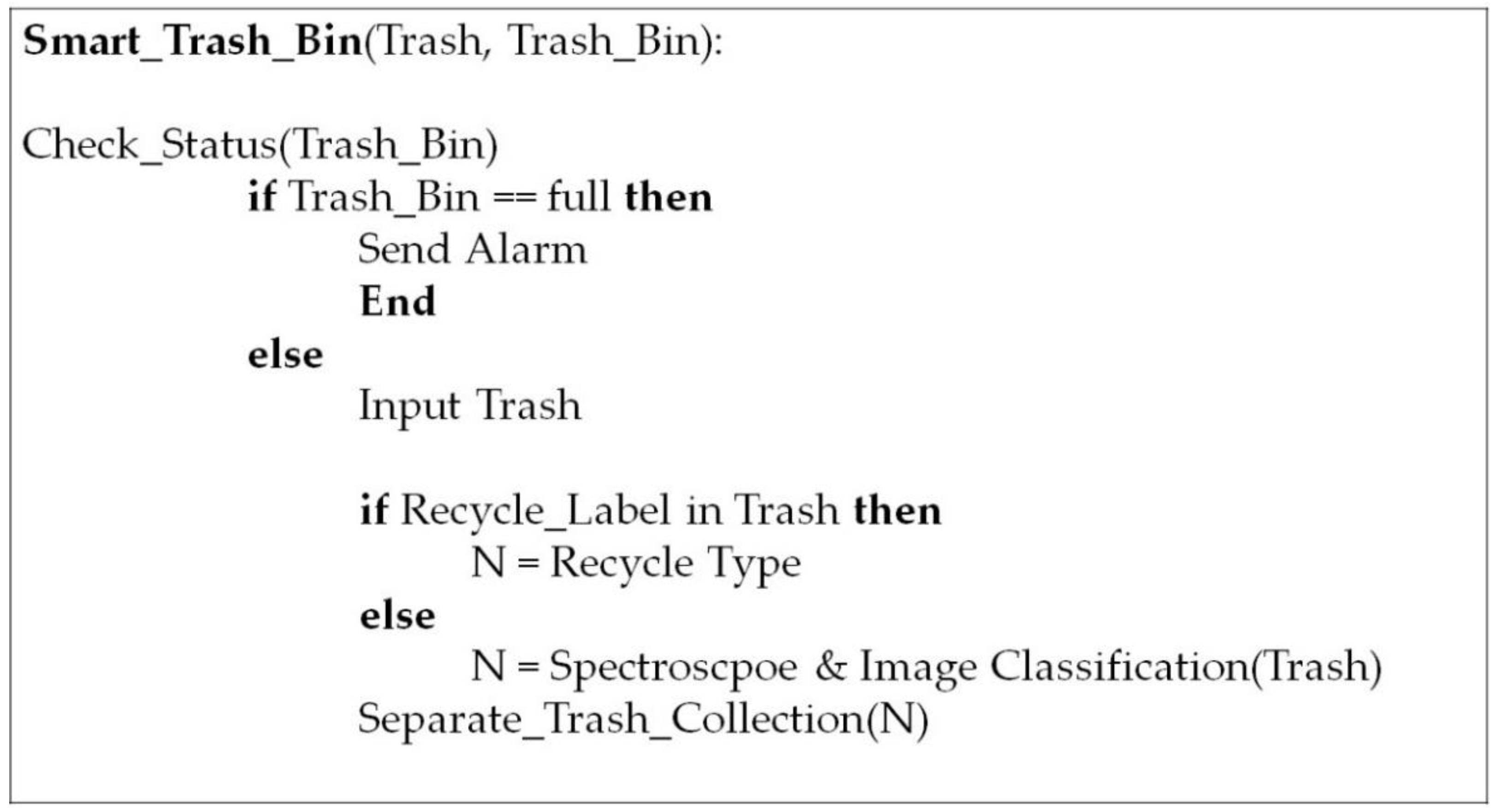
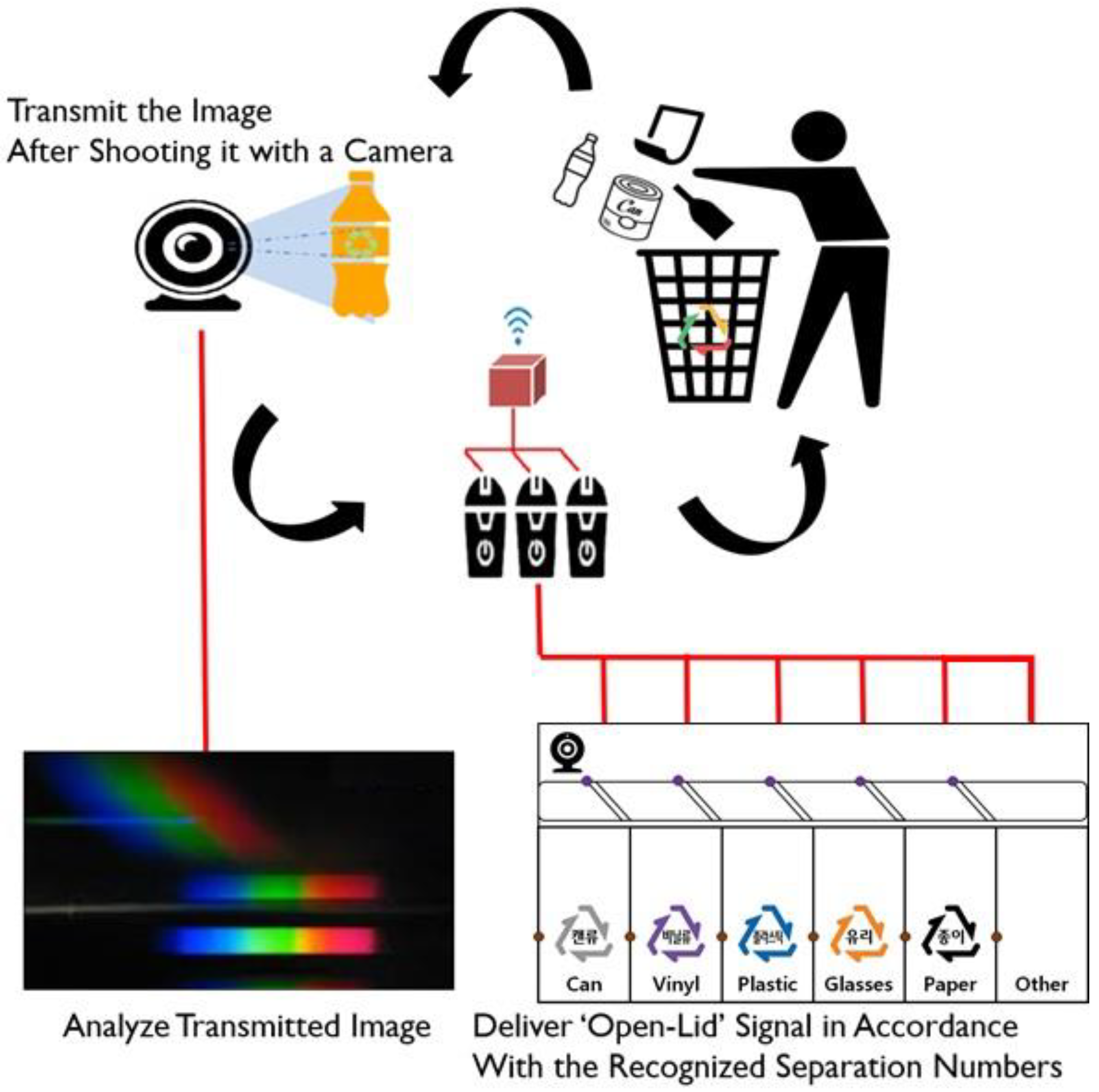

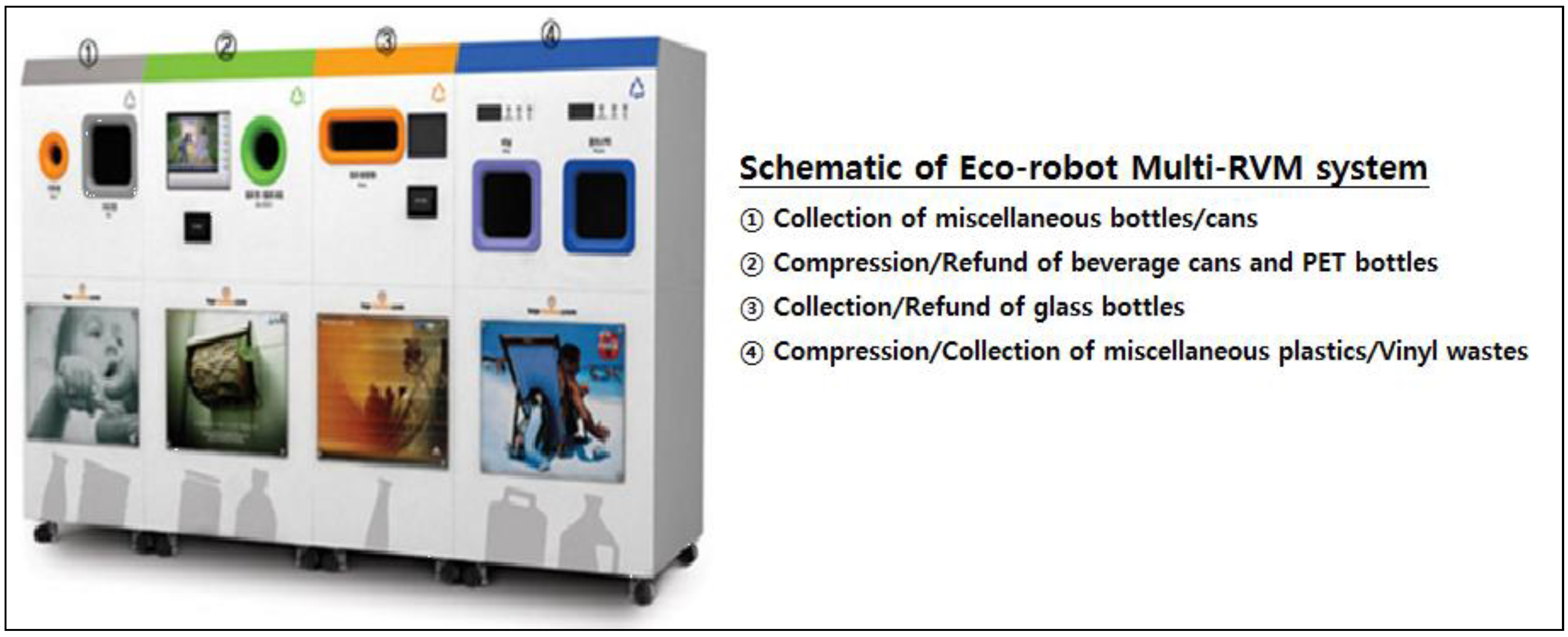
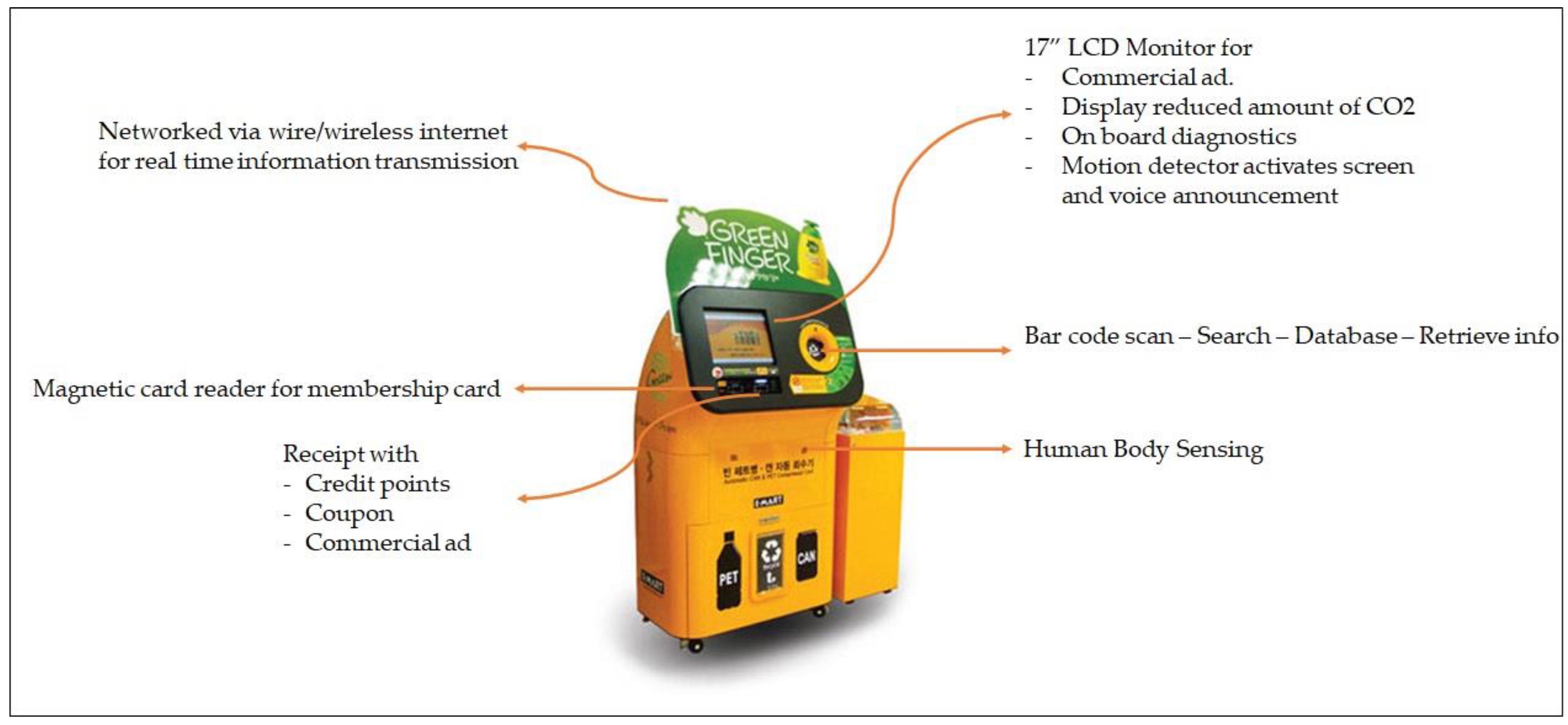

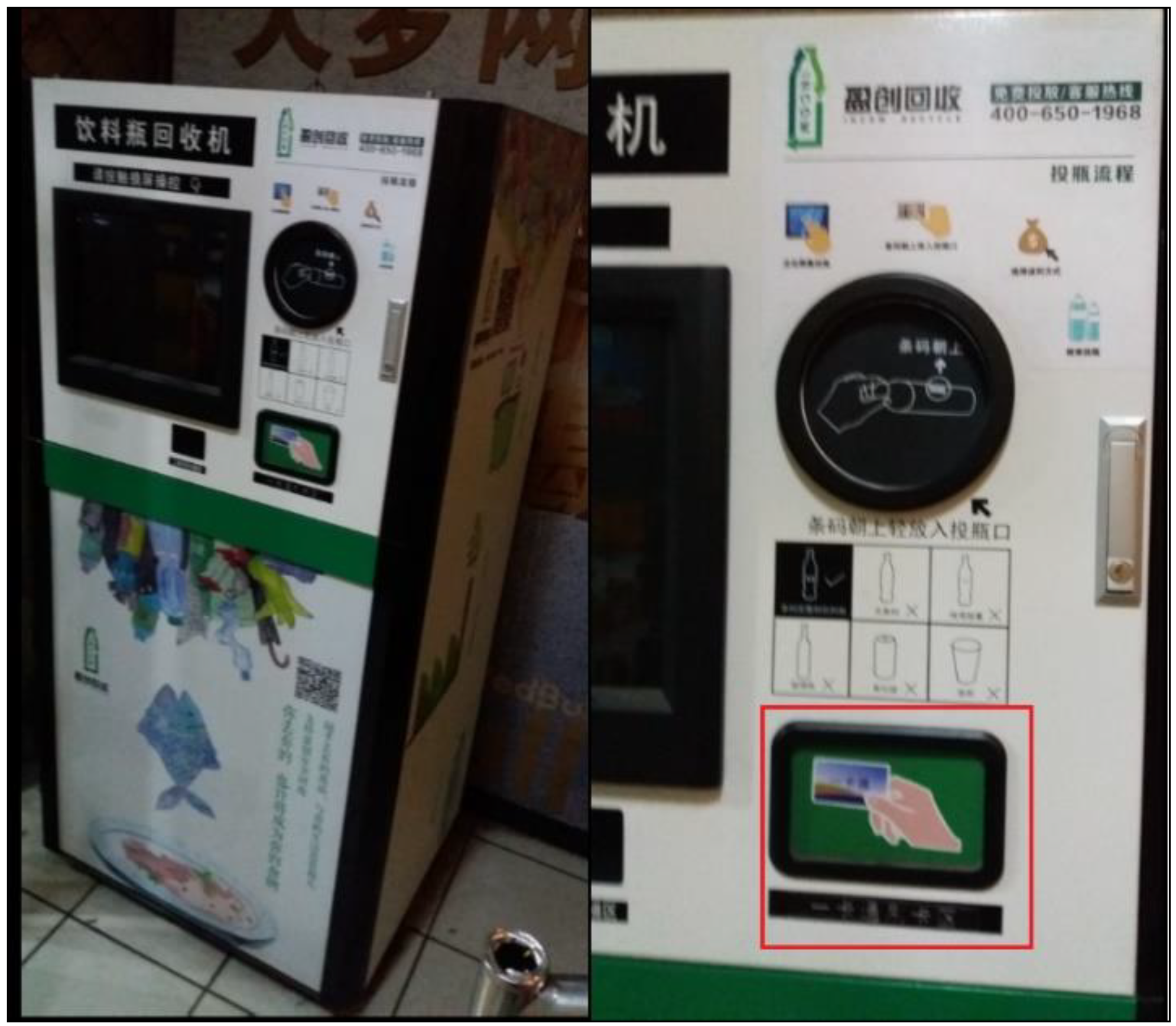


| Year | Number of Trash Boxes | Sanitation Workers |
|---|---|---|
| 1995 | 7607 | 8683 |
| 2007 | 3703 | 3256 |
| 2012 | 4724 | 3281 |
| 2013 | 4476 | 2996 |
| 2014 | 4884 | 2799 |
| 2015 | 5138 | 2563 |
| 2016 | 5640 | 2466 |
| 2017 | 5939 | 2239 |
| Year | Smart Trash Bin | “Smart Trash Bin” |
|---|---|---|
| 2013 | 998 | 4 |
| 2014 | 1080 | 2 |
| 2015 | 1070 | 6 |
| 2016 | 1140 | 5 |
| 2017 | 1250 | 20 |
| 2018 | 1280 | 32 |
| 2019 | 1460 | 45 |
| 2020 | 1334 | 82 |
| Author | Component | Function |
|---|---|---|
| Hamza Sohail et al. [17] | Ultrasonic Sensor Flame Sensor GPS | Trash Level Flame Alert Live map Android Application Trash Collection efficiency |
| Ankit Mishra et al. [18] | Wi-Fi Module Ultrasonic Sensor RFID reader Infrared Sensor LED Screen | Auto-Open/Close Function Trash Level Send Message to authority Provide Reward Profit from advertising |
| Tae-Kook Kim [19] | Ultrasonic Sensor Bluetooth Direct Current (DC) motor | Trash Level Trash Compression Android Application |
| Mohd Helmy Abd Wahab et al. [20] | Digital weight scale RFID Motor LCD | Auto-Open/Close Function Provide Reward Online Platform |
| S. Vinoth Kumar et al. [21] | Ultrasonic Sensor Force Sensor GPS | Trash Level Weight Measure of Trash Trash collection efficiently |
| Fady E. F. Samann [22] | Ultrasonic Sensor GSM Module RIP Sensor Speaker Solar Cell Panel | Trash Level Send Short Message Service (SMS) Play Audio When People Approach Power Bank Self Power |
| Steffy Thankam Wilson et al. [23] | Ultrasonic Sensor Gas Sensor Wi-Fi Module | Trash Level Bad Smell Alert Android Application |
| Author | Model | Classify Trash | Accuracy |
|---|---|---|---|
| Irfan Salimi et al. [24] | SVM | Organic, non-organic, non-trash | 82.7% |
| Mandar Satvilkar [25] | CNN XGBoost SVM RF kNN | Cardboard, glass, metal, paper, and plastic | 89% 70% 65% 62% 52% |
| Cenk Bircanoğlu et al. [26] | ResNet50 RecycleNet | Paper, glass, plastic, metal, cardboard, trash | 75% 81% |
| He-Qun Yang et al. [27] | RecycleTrashNet | Cardboard, glass, metal, paper, plastic, and other trash | 88% |
| Anh H. Vo et al. [28] | DNN-TC | Glass, paper, cardboard, plastic, metal, and trash | 94% |
| Bernardo S. Coast et al. [30] | AlexNet VGG-16 | Glass, metal, paper, and plastic | 91% 93% |
| Model | Classifiable Types | Function |
|---|---|---|
| Proposed Model | Can, vinyl, plastic, glasses, paper, and other | Trash Level Trash Classification Using Spectroscopy and image classification |
| Dr. Boomerang | Plastic bottles and cans | Trash Classification Using barcode Provide Reward |
| E-Cube Lab. | - | Trash Level Trash Compression Utilizes Solar Power Monitoring Software |
| Incom Recycle | Plastic bottles | Provide Reward |
Publisher’s Note: MDPI stays neutral with regard to jurisdictional claims in published maps and institutional affiliations. |
© 2021 by the authors. Licensee MDPI, Basel, Switzerland. This article is an open access article distributed under the terms and conditions of the Creative Commons Attribution (CC BY) license (https://creativecommons.org/licenses/by/4.0/).
Share and Cite
Huh, J.-H.; Choi, J.-H.; Seo, K. Smart Trash Bin Model Design and Future for Smart City. Appl. Sci. 2021, 11, 4810. https://doi.org/10.3390/app11114810
Huh J-H, Choi J-H, Seo K. Smart Trash Bin Model Design and Future for Smart City. Applied Sciences. 2021; 11(11):4810. https://doi.org/10.3390/app11114810
Chicago/Turabian StyleHuh, Jun-Ho, Jae-Hyeon Choi, and Kyungryong Seo. 2021. "Smart Trash Bin Model Design and Future for Smart City" Applied Sciences 11, no. 11: 4810. https://doi.org/10.3390/app11114810
APA StyleHuh, J.-H., Choi, J.-H., & Seo, K. (2021). Smart Trash Bin Model Design and Future for Smart City. Applied Sciences, 11(11), 4810. https://doi.org/10.3390/app11114810








